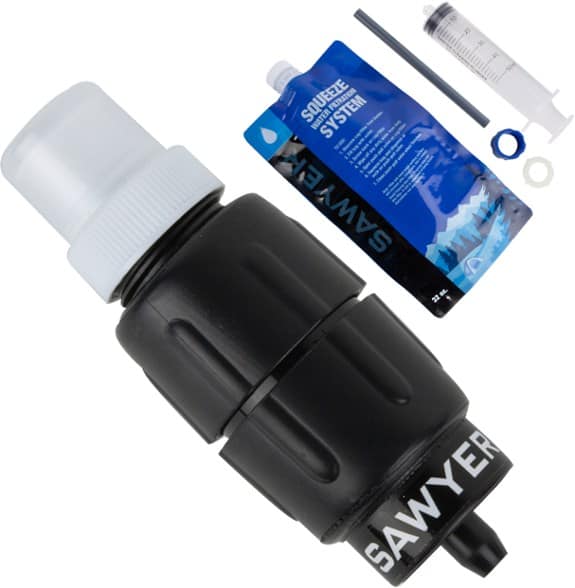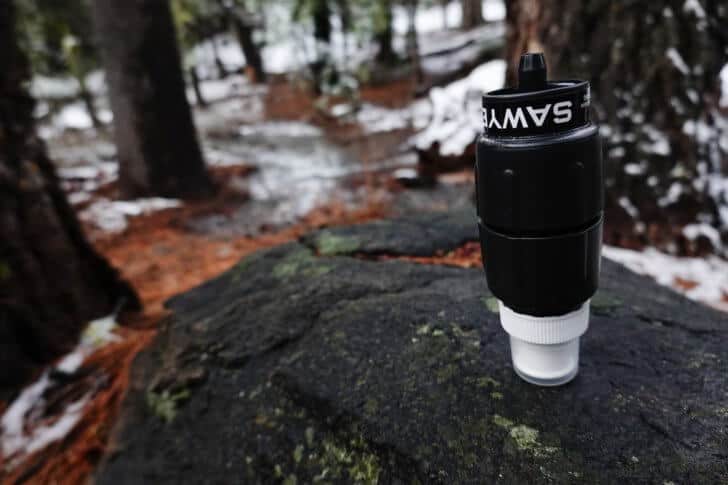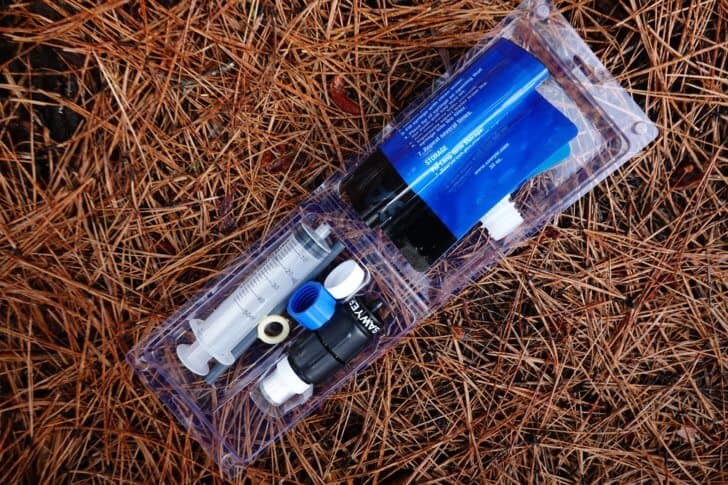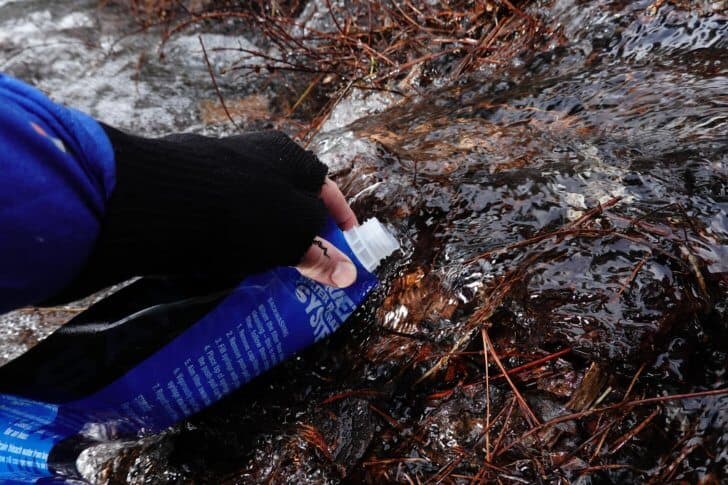Introduction

The Sawyer Micro Squeeze is the latest in Sawyer’s ongoing line of palm-sized hollow-fiber water filters. In theory, the Micro combines the flow-rate of the Sawyer Squeeze with the weight savings of the Sawyer MINI. Like its older brothers, the Micro is versatile and easily connected to any 28mm water bottles, including, of course, the beloved Smartwater Bottle. That being said, this review is not a head-to-head comparison of the three available Sawyer filters. It might be more useful to backpackers looking to cross over from chemical or ultra-violet treatment than it will be to users trying to decide if they should upgrade their current Sawyer filter.
Category Overview
Hollow-fiber filters utilize a bundle of miniscule tubes (think tiny, tiny straws) all bunched together into a matrix. The tube walls are pocked with microscopic pores: holes large enough for water to pass through, but not bacteria, cysts, or protozoa. Note that viruses are not included in this list: to take care of those, you want a purifier as opposed to a filter. In most filter systems the pore size is .1 or .2 microns.
Hollow-fiber filters offer a wonderful weight-to-performance ratio – at least at first. They are prone to clogging over the lifetime of the filter, and their performance can sometimes decrease precipitously from out-of-the-box peak flow rates, even after backflushing (methods of backflushing differ from product to product).
Lots of chemical treatment or ultraviolet uses have a story about choking down gritty, possibly tadpole-filled water. On the other hand, lots of filter users have stories about irreversibly clogged filters. In general, when using a hollow-fiber filter, it’s best to find the clearest, most sediment-free water possible.
One downside inherent in most hollow-fiber systems is this – you have to keep them above freezing. Some amount of water is more-or-less always trapped inside a hollow-fiber filter. When that water freezes, the resulting ice crystals can tear larger holes in the membrane. All sorts of things you definitely don’t want living in your lower intestines can then freely pass through these larger pores.
There’s a wide range of filters available on the market, from the 2 oz Sawyer MINI to the 16 oz, pump utilizing MSR MiniWorks Ex. We’ll consider the Sawyer Micro (and compare it to other filters) within the following framework: it belongs to a family of compact, sub-6 oz filters that utilizes .2 micron or less hollow fibers to filter a liter of water in three minutes or under using a squeezing method to force the water through the filter.
Features and Specifications

Features
- Comes with a 32 oz squeeze pouch, backwashing plunger, cleaning coupling, spare gasket, and drinking straw.
- Removes: bacteria, protozoa, and cysts (including E.Coli, giardia, vibrio cholerae, salmonella typhi, and microplastics.
- Rated for up to 100,000 gallons.
- Can be attached to standard water bottles or inline to hydration packs,
- Combines the weight of the Sawyer Mini with the flow-rate of the Sawyer Squeeze.
Specifications
- Weight of filter: 2 oz (56.69 g)
- Weight of filter (measured after ten uses): 2.2 oz (62.36 g)
- Weight of 32 oz bag (measured): 0.7 oz (19.84 g)
- Weight of cleaning coupling (measured): 0.2 oz (5.66 g)
- Total field weight (filter, 32 oz bag, and cleaning coupling): 3.2 oz (90.71 g)
- Filter pore size: 0.1 microns
- MSRP: $27.95
Performance Notes

This section will be divided into multiple parts, with each part corresponding to a step in the process of filtering water with the Sawyer Micro Squeeze.
Water Collection

The Micro comes with a collapsable 32 oz squeeze bag which serves as the primary dirty water reservoir. Bags of this type are easily filled in flowing water but are troublesome in still water – particularly if the water is shallow. Luckily my water source for this test was a swiftly flowing creek. The water was lightly sedimented but mostly clear when held up to the light. My bag filled in a matter of seconds, and I was able to hold one corner in such a way as to prevent my hands from getting wet (the ambient temperature was 36 F).
Prepping to Filter

After filling the bag, it is simple to attach the filter, flip the whole thing over, and begin squeezing into a clean water reservoir. I found attaching the filter to a Smartwater bottle to be only fractionally less easy than attaching to the squeeze bag.
Filtering
Sawyer makes a point of telling you not to squeeze too hard – the warnings are all over the packaging and the website. I can see why. It’s very tempting to squeeze as hard as you can thinking that increased force will increase flow rate. Not so. After playing around with pressure I found a steady, even pressure to be the best option.
Squeezing the bag in this way was simple. As the amount of water in the bag decreases you have to adjust your hands and the bag in order to keep the pressure on. If the water is cold, your hands will be cold as well.
It takes a little practice to get the technique down, especially because you should not wring or twist the bag. Sawyer squeeze bags have a long history of failure, partly because of misuse and partly because it’s difficult to make a lightweight product that stands up to repeated, daily hydraulic pressure.
Sawyer re-designed the bags for the Micro – they are lighter and more flexible than the originals. However, it’s still possible to find examples of the new bags rupturing. Sawyer recommends careful attention to cleaning and maintenance of the filter to prevent undue pressure (see the Backflushing section, below).
In any case, the spotty nature of squeeze bag longevity is what leads many backpackers to use Smartwater bottles as a dirty water reservoir. While you can squeeze short bursts at a time into your mouth fairly easily (or use inline with a hydration bladder) using a Smartwater bottle as reservoir for filtering multiple liters of water is a little more difficult.

To see what I mean, let’s examine the data from my initial “First Looks” flow rate testing.
Here’s the chart from my initial round of testing, in which I used the included 32 oz squeeze bag to fill a 1L Smartwater bottle to just below cap level. My Micro was brand new and was used five times with tap water prior to this test (in the packaging material Sawyer says that the first few uses will be slower because of a dry filter).
SAWYER MICRO SQUEEZE TEST – WITH POUCH
| TEST # | Time to Filter 1L (M:SS) |
| 1 | 1:30 |
| 2 | 1:40 |
| 3 | 1:29 |
| 4 | 1:44 |
| 5 | 1:49 |
Here’s a similar test, using a 1L Smartwater bottle as the dirty water reservoir instead of the included pouch.
SAWYER MICRO SQUEEZE TEST – WITH BOTTLE
| TEST # | Time to Filter 1L (M:SS) |
| 1 | 2:51 |
| 2 | 2:24 |
| 3 | 2:44 |
| 4 | 3:12 |
| 5 | 3:00 |
And for comparison purposes, here’s data from an MSR TrailShot filter from the same water source on the same day. The TrailShot was lightly used and well-cleaned before this test.
MSR TRAILSHOT TEST
| TEST # | Time to Filter 1L (M:SS) |
| 1 | 2:47 |
| 2 | 2:45 |
| 3 | 2:50 |
| 4 | 2:44 |
| 5 | 2:55 |
Before we go any further, some caveats.
- These tests are by no means meant to be comprehensive. Flow rate is highly dependent upon water clarity and age of filter (and by age, we mean “the amount of gunk a given filter has had to deal with in its lifespan). This data is merely meant to serve as a baseline.
- Why didn’t I compare the Micro to the Squeeze or Mini? Why did I use the MSR Trailshot, which functions in a slightly different way, as opposed to similar products from the same brand which functions more or less identically? Short answer: I don’t own the Sawyer Mini or Squeeze. Even if I did, I would have needed filters of comparable age and use for the data to be relevant.
- This is a First Looks review, meant only to record initial thoughts on a product. There’s undoubtedly an extensive BPL Filter Gear Guide on the horizon in which all the above factors will be taken into account. Until then, hopefully, these little tests are helpful.
In my tests, using the 32 oz squeeze bag was close to a minute faster per-liter than using a Smartwater bottle. The reason is this: After squeezing about a quarter of the water from the bottle, the bottle deforms and it becomes difficult to exert enough pressure to keep a steady flow going. The only solution is to flip the bottle over, unscrew the filter enough to allow air to flow into the bottle and restore pressure, re-screw the filter, flip back over, and continue filtering. Repeating this process two-to-three times per liter of water is what accounts for the increased time when filtering with a Smartwater bottle. In short – I’d opt for the squeeze bag over a bottle any day. But, if the squeeze bag breaks, you may not have a choice.
Backflushing
All filters clog. Backflushing is a necessary facet of successful filter use, and the ease with which the process happens in the field is a major performance consideration. The Sawyer Micro not only comes with a kind of plunger for high-pressure at-home backflushing but also an adaptor ring that allows you to backflush in the field using a water reservoir. This is handy, light, and easy – provided you don’t lose the ring.
Commentary

I can say this: The Micro is light, the Micro is cheap, and the Micro seems to work well enough, at least for shorter trips and particularly when using the included squeeze bag. Watch out for cold hands, and be careful with the bag. Backflush regularly – maybe even once a day while in the field, more if your water sources are bad.
Anecdotal evidence from our forum seems to suggest that the classic Squeeze has a better flow rate than the Micro.
I’m worried that Micro’s filter isn’t replaceable. If it did happen to freeze or become irredeemably clogged, I’d rather just replace a filter than a whole piece of gear. That being said, a replacement filter for the TrailShot is more expensive than buying the Micro all over again.
I like Sawyer’s pressured backflushing system more than the “just shake it” system some other brands offer – but again I have no hard evidence that it is any better. It just seems like it would be.
Which brings me to my final point: writing this review made Ryan Jordan and I decide that BPL needs a FilterBench Protocol similar to our recent StoveBench Protocol. Only then can the performance metrics of the category (flow rate, resistance to clogging, resistance to failure when frozen, ability to clean when it is clogged) be fairly judged. At the very least a sort of FilterBench Lite test is in order, wherein brand new Squeeze, MINI, and Micro filters are pitted head-to-head under a variety of stressors.
Until then, it’s hard to definitively recommend the Sawyer Micro over any other available filters in this category (see Compared To… section below).
Product Strengths and Limitations
Strengths
- Tries to match the weight of the Sawyer MINI while maintaining an increased flow-rate from that model.
- Versatile and adaptable.
- Can be used inline with a hydration system, or you can squeeze directly into mouth.
- No need to balance over a water source in order to filter water (like with the MSR TrailShot).
- Cleaning coupling means you can do a decent backflush cleaning in the field.
- Rated for 378,541 L (100,000 gallons).
Limitations
- Works best with the included bag – filtering with a Smartwater bottle is a pain.
- Sawyer squeeze bags have a historic durability issue.
- System requires the possibility of getting hands wet in order to fill a dirty water reservoir.
- Gathering water from non-flowing sources is difficult with Sawyer bag.
- Filter is not interchangeable. If it does become irreversibly clogged or damaged, the whole thing is trash.
- Squeezing can get tiresome.
- Hands will get cold while filtering cold water.
Compared To…
| PRODUCT | MSRP | Weight (oz) | Pressure type | 28mm compatibility | In-line gravity or hydration system compatibility | Filter pore size (microns) | Estimated lifespan (heavily dependent upon water quality and regular care; in L) | Replaceable filter |
|---|---|---|---|---|---|---|---|---|
| Sawyer Micro Squeeze | $27.95 | 2 | Squeeze bag or bottle | yes | Yes | 0.1 | 378,541 | No |
| Sawyer MINI | $14.89 | 2 | Squeeze bag or bottle | yes | Yes | 0.1 | 378,541 | No |
| Sawyer Squeeze | $39.95 | 3 | Squeeze bag or bottle | Yes | Yes | 0.1 | unavailable | no |
| MSR TrailShot | $49.95 | 5 | Integrated squeeze bulb | No | No (but the MSR Trail Base system comes with an in-line filter that is essentially the Trail Shot) | 0.2 | 2,000 | yes |
| Katadyn BeFree | $44.95 | 2.3 | Squeeze bag | No (fits 43 mm) | No | 0.1 | 1,000 | yes |
Where to Buy
- Buy the Sawyer Micro Squeeze at REI
Related Content
- We did a quick review of the MSR Trail Base system a while back. Give it a read.
- Want some more user thoughts on the Sawyer Squeeze Micro? Check out our forum.
Review Disclosure
- How we acquired these products: Product(s) discussed in this review were either acquired by the author from a retailer or otherwise provided by the manufacturer at a discount/donation with no obligation to provide media coverage or a product review to the manufacturer(s).
- We do not accept money or in-kind compensation for guaranteed media coverage: Backpacking Light does not accept compensation or donated product in exchange for guaranteed media placement or product review coverage.
- Affiliate links: Some (but not all) of the links in this review may be “affiliate” links, which means if you click on a link to one of our affiliate partners (usually a retailer site), and subsequently make a purchase with that retailer, we receive a small commission. This helps us fund our editorial projects, podcasts, instructional webinars, and more, and we appreciate it a lot! Thank you for supporting Backpacking Light!




Home › Forums › Sawyer Micro-Squeeze Review (First Looks)